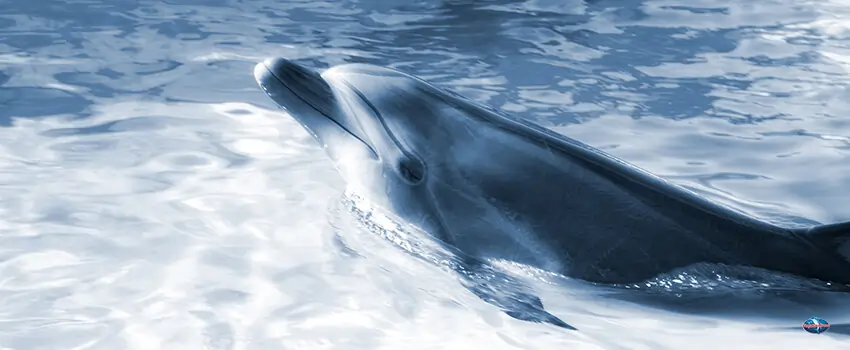Find out how scientists are deciphering and decoding dolphin sounds through dolphin music. Although summoning dolphins with a flute may sound like something out of “The Legend of Zelda,” Australian scientists are exploring how do dolphins communicate using music as a potential gateway language for interaction with cetaceans. This new dolphin information might be the key to better understanding these lovable creatures.
How Do Dolphins Communicate?
Dolphin communication involves two primary types of dolphin sounds: clicks and whistles. Dolphins use clicks for echolocation to sense their environment, while whistles facilitate social interaction within their group and possibly with other species. A “signature whistle” is a unique sound dolphins use to identify themselves, answering the question, do dolphins sing in their own way.
Dolphin Echolocation
Do dolphins use echolocation? Yes, porpoises and dolphins rely on echolocation, using higher-frequency dolphin sounds that travel shorter distances.
Most toothed whales, including dolphins, have excellent eyesight above and below water. However, dolphin echolocation is critical for navigation and hunting underwater. Dolphins emit sound waves and interpret their echoes to detect objects and creatures, creating a mental map of their surroundings. This allows them to find prey in murky waters or hidden under sand, showcasing the power of dolphin communication sounds.
How do dolphins hear? While dolphins have ears, they lack external ear structures for streamlining in water. Do dolphins have ears? Their ear canals are internal, and they hear via specialized jawbone structures that capture dolphin sounds.
“`
Dolphin Signature Whistle
Bottlenose dolphins use a signature whistle, a distinct dolphin communication sound to identify themselves. Scientists can distinguish individual dolphins by these whistles, which convey identity, location, and possibly emotional state. These whistles, typically between 7 and 15 kHz and lasting less than a second, support social interactions, mother-calf reunions, and group affiliations.
After giving birth, a mother dolphin may whistle continuously to her calf for days, aiding acoustic imprinting. By one month, a calf can develop its own signature whistle, reinforcing dolphin communication.
While dolphins mimic each other’s whistles, there’s no evidence they speak a language, but their whistles are a form of dolphin music in their social context.
Loud Impulse Sounds and Other Sounds
Loud impulse dolphin sounds may confuse predators or stun prey, though this is unconfirmed. Dolphins also produce sounds above water when breaching, jumping, or striking the surface with flippers or flukes, potentially as part of dolphin communication sounds. These actions add to the repertoire of what noise does a dolphin make.
“`
Dolphin Sound and Music
Do dolphins like music? Researchers from The Australian National University tested this in December 2021 in Port Stephens, New South Wales, exploring dolphin music interactions.
High-pitched instruments like flutes, piccolos, and opera singing, mimicking dolphin sounds, attracted dolphins. A wide range of instruments was crucial to match the frequencies of dolphin communication sounds, far beyond human vocal limits.
Dr. Olivia De Bergerac, a neuroscientist and dolphin expert, notes that cetaceans process information rapidly, making dolphin music a faster communication medium than words. Twenty years ago, indigenous Australian Bill Smith used a didgeridoo to connect with dolphins, and French singer Camille later bonded with them through song. De Bergerac adds, Singing and playing music is the best way to encourage encounters with wild dolphins.
Flutist Sally Walker’s performances prompted dolphins to linger near the boat, mirroring their response to the didgeridoo. Dolphins followed the group as they swam, drawn by the dolphin music. Cetaceans, including belugas, have responded to music, such as classical pieces used to guide a pod to safety.
Researchers used hydrophones to record dolphin communication sounds and analyzed them as musical compositions. Future experiments aim to play dolphin music at higher octaves through underwater speakers, testing dolphin reactions to varying speeds and frequencies. They plan to lower dolphin sounds by two to three octaves and transcribe them to identify musical structures, similar to bird song research.
De Bergerac envisions a TV documentary featuring indigenous Australian knowledge of dolphin music and broadcasting Sally Walker’s music underwater to engage hundreds of dolphins.
Sunshine Scenic Tours Takes You on a Dolphin Cruise
Curious about how do dolphins communicate or what noise does a dolphin make? Discover these answers and more on a dolphin cruise in John’s Pass with Sunshine Scenic Tours. Book now to explore dolphin communication and dolphin sounds in their natural habitat.











